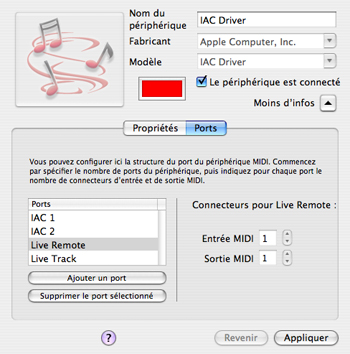|
DyNAmic is a sophisticated step sequencer managed by a Max patch, and tightly connected to a Live rack. The Live rack consisting of two Simpler devices containing basic sine waves for low and high percussions, a Simpler containing noise for your hi-hats, and one containing a square wave for your bass sounds. In addition, each Simpler feeds an Autofilter and Redux for effects modulation, all of this being controlled from your Lemur of course.
Regarding the setup, begin by creating two virtual Midi cables for communication between Max and Live. On OSX, use Apple’s own IAC and create two dedicated virtual cables. These could be named Live Remote and Live Track for instance, but of course these can take any name you like. The first cable will be used for transmitting MIDI controller data to Live, the second for transmitting MIDI note data. On PC, we recommend using MIDI Yoke virtual cables.

|
When you’re done, load the Ableton Live set DyNAmic.als and go to the Preferences’ MIDI configuration page. Select the Live Remote input port and set it to Remote.
Then set the Live Track input port to Track.
Now use the JazzEditor and load up the Lemur patch DyNAmic.jzml.
If you don’t own Cycling74’s Max 5, download the free Runtime version from . Load the Max patch DyNAmic.maxpat and follow the steps to make Max5, Live and your Lemur communicate in a civilized manner:
-
Make sure you fill in the correct IP address and OSC port of your Lemur and press return to confirm each step.
-
Choose the two virtual Midi ports you configured earlier.
-
Make sure the ad rewire audio driver is chosen.
-
Check the box to start Rewire sync between Live and Max.
On your Lemur, enter the IP address of your computer’s ethernet interface and use port 8000:
If everything is set up correctly, you should now be ready to start playing. Watch the tutorial video for a tour of the template by the author himself:
Credits:
Template created by Mikaël Björk aka Lo-Fi Massahkah.
|



